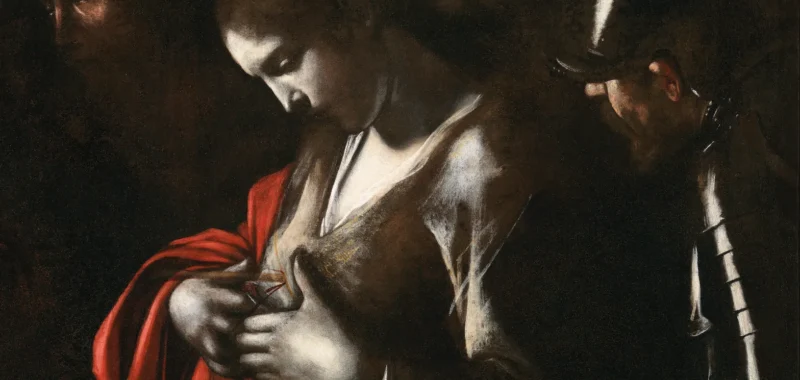LONDON — Darkness … light and dark … light and dark in combination … chiaroscuro. These words sprang to mind the moment I stepped into Gallery 46 of the National Gallery. Why? Because the gallery itself, which is exhibiting what is said to be Caravaggio’s very last painting, was so dark that the air felt thick with tar.
Luckily, two points of illumination directly ahead of me guided my way forward, like a pilgrim to a shrine: two paintings by Caravaggio himself, lit by more than the mysterious lighting of the paintings themselves.
Caravaggio, as a painter and a man, was a mixture of light and dark. In thinking about him, we are forced to accommodate both the weight of the paintings that he made and the weight of his fascinating and troubled, if not dangerous and violent, short life. The very the idea of the artist — a murderer on the run from the authorities for four years — is heavy with the grating, knife-edge expectation of violence and gruesomeness and tragedy, especially the late paintings.
And what better a way for him to show this off than by mastering chiaroscuro, by playing so deftly, time and again, with the very idea of emerging from the shadows? He excelled at chiaroscuro light emerging from dark, or perhaps light in slippery and often theatrical combination with dark, and the interplay of these two extremes. He did this to create palpable atmospheres: night and hushedness, the near strangulating heat and reek of intimacy, the secrecy of chance assignations.

Just two paintings are in this show. Both were made fairly late; both are in perplexed mourning over their subject matter; and both emerge from dark places. In “Salome Receives the Head of John the Baptist” (c. 1609–10), an uncouth executioner with a battered face — Caravaggio too once took a terrible battering to his face, badly disfiguring it, in a fight — grasps a severed head on a platter by a clump of hair. His left hand rests on the crossbar of his sword, the weapon of choice. The ghastly jaundice-yellow of the dead prophet’s face is enough to make any onlooker gasp. The executioner’s gesture and expression are brutally matter-of-fact — after all, he is a professional — whereas Salome cannot bear to look in the head’s direction, or to contemplate the fact that her airily expressed wish (prompted by her mother) to have John the Baptist’s head parted from his body and served up this way should have been granted with such ease. An old woman leans over the shoulder of Salome, pained, bewildered, hands tightly clasped, cheeks shriveled. Each of the three figures (as well as the head) is individually lit. As if chanced upon by accident, freshly emerged from the shadows, they seem to say: contemplate this grisly scene.
“The Martyrdom of St. Ursula” (1610) is darker still, and a much more complicated, messy, and feverish composition — a crowding of partly lit bodies thrown and squeezed against each other, the gripping and grasping of hands. A saintly gesture is at its center, a cupping of hands whose meaning emerges only by close looking.

St. Ursula is staring downward — first noticeable is the dazzle and shapely swelling of the red fabric at her waist, and the way she has caught it up so that it seems to rise in graceful folds. A wealthy old man to the left lunges forward, thrusting out his left arm protectively. A soldier, defined by the gleam of lit metal on his sleeve and helmet, leans in from the right. A bearded young man (Caravaggio himself; he has placed himself at center of his painted drama) looks across her shoulder, open-mouthed. It is all too late. The arrow has found its home.
St. Ursula, though pallid, looks curiously serene, as if she is contemplating an inevitability. Rays of light sanctify the scene.
Three weeks after completing this painting, Caravaggio was dead. Giovanni Baglione, writing in 1642, gives us the facts of his dying: “… in desperation he started out along the beach under the heat of the July sun, trying to catch sight of the vessel that had his belongings. Finally, he came to a place where he was put to bed with a raging fever; and so, without the aid of God or man, in a few days he died, as miserably as he had lived.”
The Last Caravaggio continues at the National Gallery (Trafalgar Square, London, England) through July 21. The exhibition was curated by Francesca Whitlum-Cooper.

